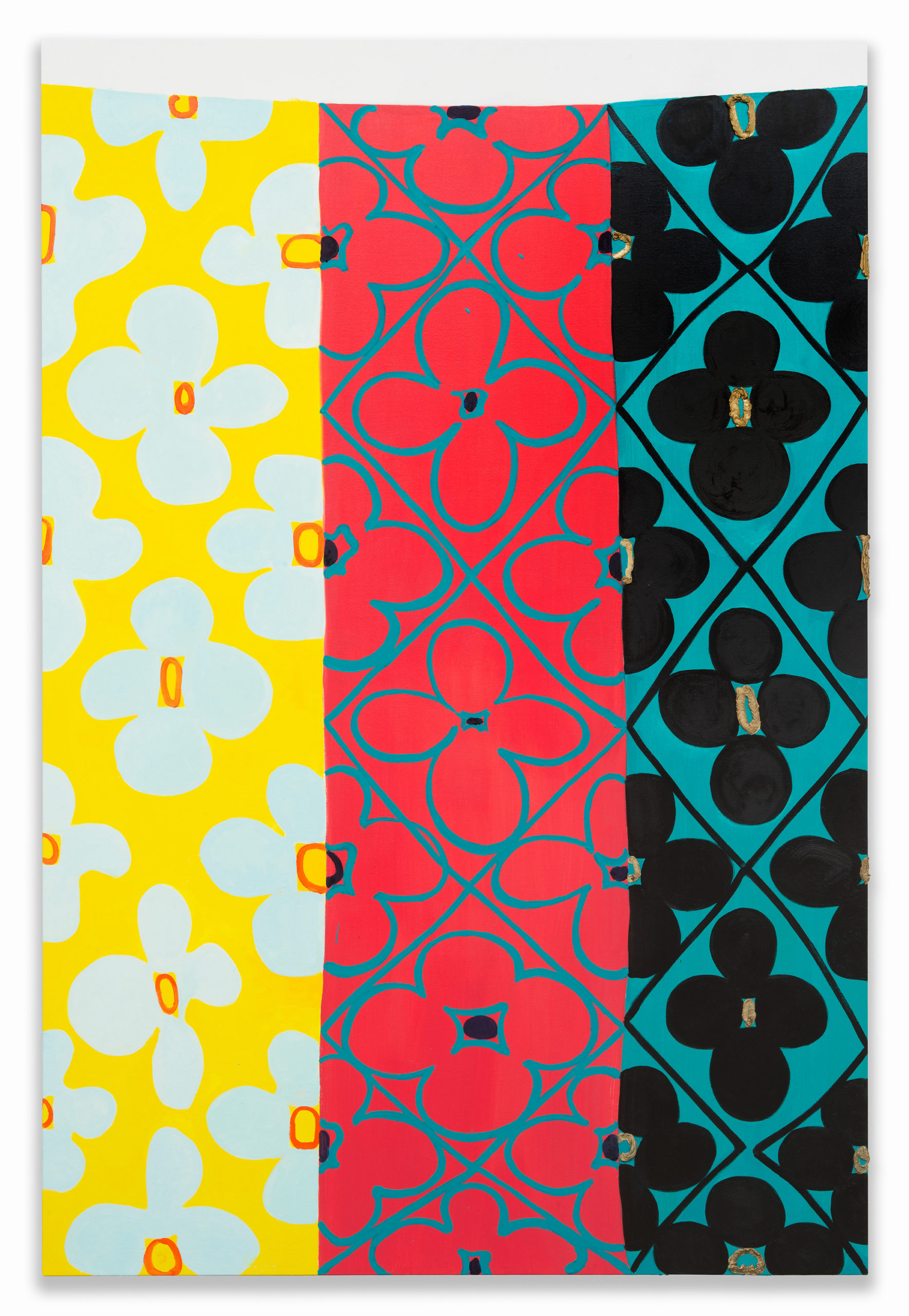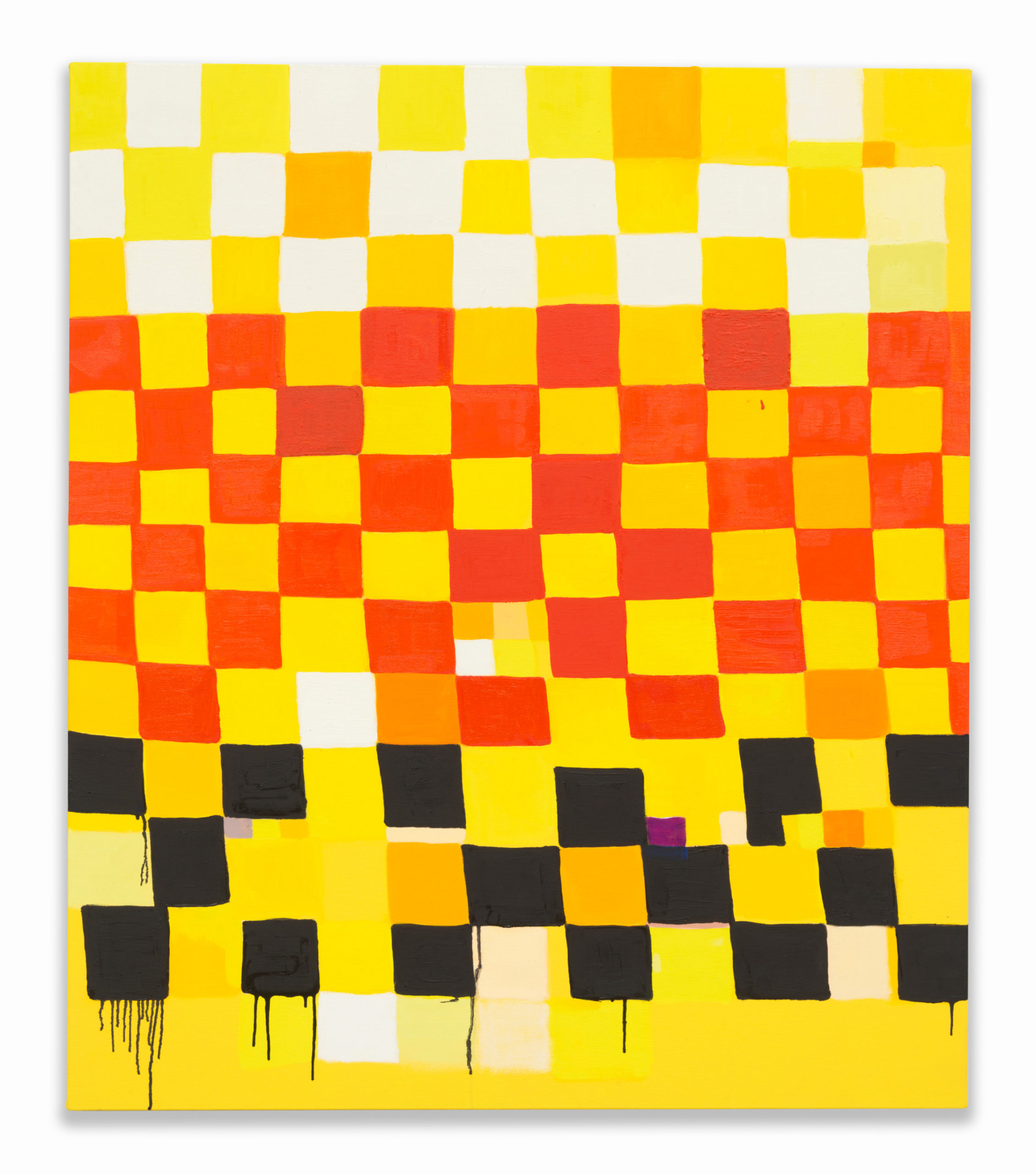Judy Ledgerwood’s Playfully Subversive Patterns
What distinguishes Ledgerwood’s work from the earlier generation of women artists working in the domain of Pattern and Decoration is its bluntness and humor.
John Yau | February 9
 Judy Ledgerwood, “First Color” (2022), oil on canvas, 15 inches x 15 inches (all images courtesy Denny Gallery)
Judy Ledgerwood, “First Color” (2022), oil on canvas, 15 inches x 15 inches (all images courtesy Denny Gallery)
A lot of writers, myself included, have connected Judy Ledgerwood’s exuberant abstractions to the Pattern and Decoration art movement. Historically speaking, Pattern and Decoration (1972–1985) challenged the canon-making orthodoxies and conventions that dominated much art in the 1960s and ’70s, and that continue to cast their shadow. This challenge to the canon, which manifests itself as celebrations of the female body and sexuality in Ledgerwood’s work, is inseparable from her vocabulary of hand-painted quatrefoils, interlocking triangles, and thickly painted labial shapes. What distinguishes Ledgerwood’s work from the earlier generation of women artists working in the domain of Pattern and Decoration is its bluntness and humor.
Like Mary Heilmann, whose bright geometric abstractions loosened the rigidity and joylessness of Minimalism, Ledgerwood has a current of impropriety, painterliness, waywardness, and humor in her work, upending the symmetry and repetition that are common to decorative and ornamental arts. Ledgerwood’s ribald interruptions and optical shifts are part of what holds the viewer’s attention.
“Jaywalking” (2022), the largest painting in her debut exhibition, Judy Ledgerwood: Sunny, at Denny Gallery (January 7–February 11, 2023), exemplifies how far the artist will go to undo P&D’s conventions of structure and repetition without abandoning them altogether. Starting on the left side of the sagging top edge, Ledgerwood has painted irregular yellow, turquoise, blue, and black triangles in varying sizes, along with a few rectangles that fit together. The monochromatic triangles, which contain incomplete and complete quatrefoils, descend down the surface, with a few drips of color here and there.
The exception is a large, oddly shaped white area descending from part of the top edge. In this area, Ledgerwood has outlined incomplete black quatrefoils with a red dot in the center. This incomplete quatrefoil is echoed by the flat ones painted within the triangles. Other than the use of the same vocabulary throughout, there is no underlying pattern or order to the arrangement of the triangles.
 Judy Ledgerwood, “Jaywalking” (2022), oil on canvas, 84 inches x 96 inches
Judy Ledgerwood, “Jaywalking” (2022), oil on canvas, 84 inches x 96 inches
The cropped, cartoonish quatrefoil shapes of “Jaywalking” evoke male and female genitalia; the repetition of an irregular red orb works both formally and evocatively. Working with a limited vocabulary, Ledgerwood’s improvisational approach is anarchic, playful, matter-of-fact, and direct. She does not seem to go back over the painting or feel the need to revise and fuss. It’s as if Henri Matisse’s cut-outs were romanced by anthropomorphic cartoon mice. That humor — which is rarely seen in art associated with the P&D movement — is just one of the many aspects contributing to the artist’s singularity.
In “Footsteps” (2022), Ledgerwood divides the painting into three vertical bands, in yellow, red, and turquoise. In the yellow area is a staggered arrangement of white quatrefoils, while in the red band are quatrefoils within turquoise diamonds. And in the turquoise band are black quatrefoils within black diamonds. The suggestive metallic outline of a thick vertical almond is added to the shapes in this band. The balance between symmetry and repetition is always off-kilter and tweaked, largely because Ledgerwood paints directly onto the canvas without going back into the work.
Using a simple, open vocabulary in conjunction with a palette of bright yellows, deep blues, reds, black, and turquoise, Ledgerwood keeps finding ways to be improvisational within the domain of Pattern and Decoration. Interruptions and shifts in the patterns lift the work out of the soothing predictability of repetition. Sometimes her quatrefoil drawings are positively goofy, underscoring the elasticity of the shape. Given her commemoration of female sexuality, how might we read these material signs of change and adaptability? Paint is always both form and symbol in these works, which significantly distinguishes her paintings from those of her predecessors.
The deeper tension running through Ledgerwood’s work is between structure and improvisation, order and play. By always keeping both in close proximity, she has found a way to be painterly and direct — something associated with Abstract Expressionism more than Pattern and Decoration. More importantly, she has expanded on something that was central to Abstract Expressionism, which subsequent generations have suppressed or ignored: its vulgarity, as found in Willem de Kooning’s “Women” paintings. However, the vulgarity in Ledgerwood’s work is explicitly female — preposterous and candid. Indecency and decorum are never completely cleaved from each other in her art, and that combination offers a lot to ponder.
 Judy Ledgerwood, “Footsteps” (2022), oil on canvas, 72 inches x 48 inches
Judy Ledgerwood, “Footsteps” (2022), oil on canvas, 72 inches x 48 inches
 Judy Ledgerwood, “Plato’s Primaries” (2022), oil on canvas, 44 inches x 38 inches
Judy Ledgerwood, “Plato’s Primaries” (2022), oil on canvas, 44 inches x 38 inches
